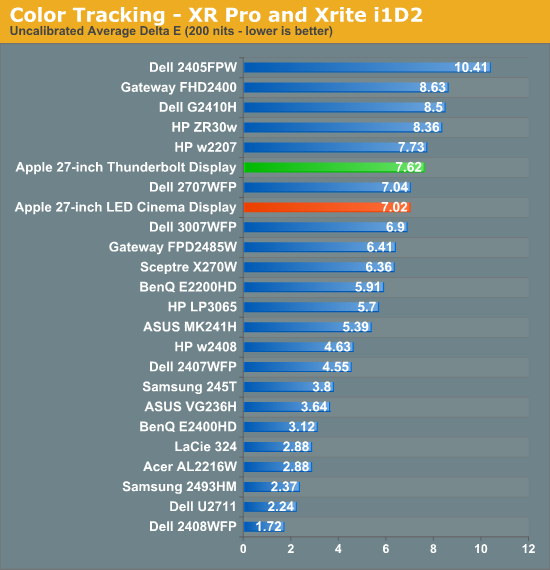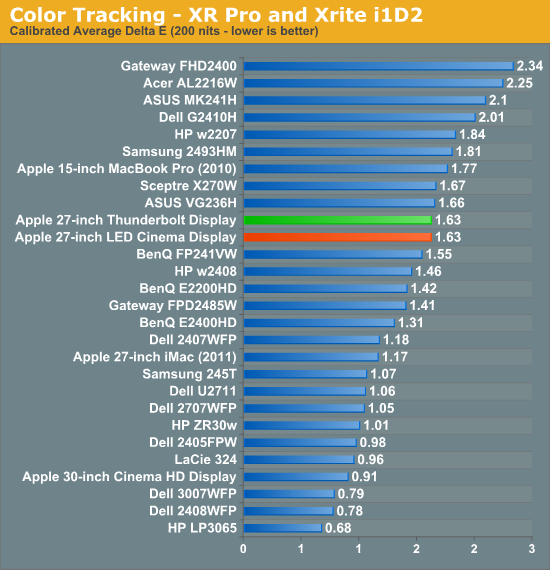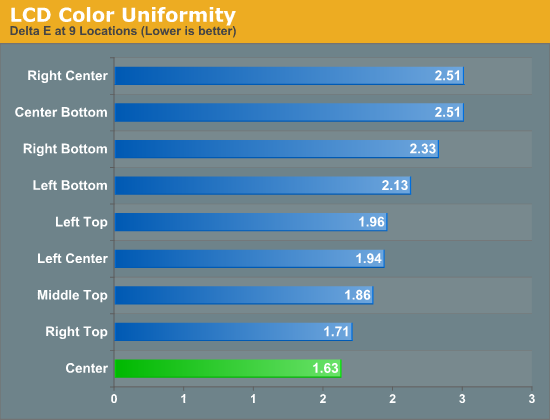The Apple Thunderbolt Display Review
by Anand Lal Shimpi on September 23, 2011 2:56 AM EST- Posted in
- Displays
- Mac
- Apple
- Thunderbolt
- Thunderbolt Display
Display Testing
With all of the extra connectivity there is to test with the Thunderbolt Display we can't forget the actual panel testing. Thankfully this part is pretty simple, the display characteristics are near identical to the 27-inch LED Cinema Display we reviewed last year.
Color Quality
We report two main quality metrics in our display reviews: color accuracy (Delta-E) and color gamut. Color gamut refers to the range of colors the display is able to represent with respect to some color space. In this case, our reference is the AdobeRGB 1998 color space, which is larger than the sRGB color space. So our percentages are reported with respect to this number, and larger is generally better.
Color accuracy (Delta E) refers to the display’s ability to display the correct color requested by the GPU and OS. The difference between the color represented by the display, and the color requested by the GPU is our Delta-E, and lower is better here. In practice, a Delta E under 1.0 is perfect - the chromatic sensitivity of the human eye is not great enough to distinguish a difference. Moving up, a Delta E of 2.0 or less is generally considered fit for use in a professional imaging environment - it isn’t perfect, but it’s hard to gauge the difference. Finally, Delta E of 4.0 and above is considered visible with the human eye. Of course, the big consideration here is frame of reference; unless you have another monitor or some print samples (color checker card) to compare your display with, you probably won’t notice. That is, until you print or view media on another monitor. Then the difference will no doubt be apparent.
As I mentioned in our earlier reviews, we’ve updated our display test bench. We’ve deprecated the Monaco Optix XR Pro colorimeter in favor of an Xrite i1D2 since there are no longer up-to-date drivers for modern platforms.
For these tests, we calibrate the display and try to obtain the best Delta-E we can get at 200 nits of brightness for normal use. We target 6500K and a gamma of 2.2, but sometimes the best performance lies at native temperature and another gamma, so we try to find what the absolute best performance could be. We also take an uncalibrated measurement to show performance out of the box using either the manufacturer supplied color profile, or a generic one with no LUT data. For all of these, dynamic contrast is disabled.

Uncalibrated performance remains fairly similar to last year's LED Cinema Display, however once calibrated the Thunderbolt Display is spot on with its predecessor:

As we mentioned earlier, a sub 2.0 delta E is good enough for professional use. Although not perfect the Thunderbolt Display falls within that range for sure.


We measured slightly lower color gamut on the Thunderbolt Display than the original LED Cinema Display, however the result was much closer to the 2011 27-inch iMac. I couldn't visibly tell any differences and Apple indicates that color gamut shouldn't have changed, so it's quite possible that the differences here are due to our colorimeter and not the panel.
Color Uniformity
Now for color consistency, we take our best calibration profile from the very center at 200 nits and test color accuracy at 9 different places around the LCD display in an evenly distributed grid. We’ve shown before that calibration is localized across the display, partly due to the brightness not being uniform, partly due to the discrete nature of the display itself.

The Thunderbolt Display was fairly uniform across its surface, something we noticed in reviewing the 27-inch LED Cinema Display last year. Uniformity is actually better on this panel than the one we reviewed last year, although in both cases I couldn't really tell any differences.
Peak brightness appears down slightly, but so are the black levels which result in a slightly better contrast ratio. Apple is also calibrating these things at the factory now so white points are now set at around 6300K vs. 7100K on the original 27-inch LED Cinema Display.










275 Comments
View All Comments
decryption - Friday, September 23, 2011 - link
No mention of how the built in Intel graphics perform on the high res screen? It was an initial concern of mine when the new MBA was released - how it would perform at that high resolution when paired up to a Mac running the 3000 HD graphics?Any UI lag? (e.g: mission control, swiping full screen apps, etc.)
boblozano - Friday, September 23, 2011 - link
Been using this combo for a couple of days and it's just about perfect. No lag, no complaints.I'd probably like usb3 and an sd reader as well, but those are nits.
MonkeyPaw - Friday, September 23, 2011 - link
I am surprised there's no card reader, but that's amendable by the USB. I don't understand the lack of audio ports. Macs are primarily media machines--how could they forget audio ports?!I guess you could use a USB sound card?
JasperJanssen - Saturday, September 24, 2011 - link
My guess is, Apple considers the humble analog audio port to be a dodo, except for use while actually on the move. But that's just speculation.All of the recent Intel-based macs that have been released, except the MacBook Air (and the Pro, which separates them), have an analog port that doubles as an optical output by plugging in the right (mini-TOSlink) optical cable -- maybe they would only want to include an audio port if it also included that optical part, which may well either make the port too deep for the regular port-location, and/or simply be too expensive. You could put a deeper port on the side of the monitor instead of the rear, but that would be both ugly and pretty expensive, as you'd have to add a whole extra PCB including a cable that goes to it.
Come to think of it, I'm not sure that at the location of the other port there is enough depth even for a regular 3.5mm jack, let alone a miniTOSlink variant. A 3.5mm jack is about 15-20 mm long and might well simply not fit between the aluminium back and the display backlight.
TypeS - Friday, September 23, 2011 - link
I really don't understand why people ponder this. Intel's integrated graphics don't do much for gaming at high resolutions (do AMD and NVIDIA's IGPS either?), but they've been fine for years now for high resolution monitors.Ryan Smith - Friday, September 23, 2011 - link
If you check the video Anand made for this article, he goes into more detail about MBA performance hooked up to such a large monitor. Overall the performance is respectable, but there are points where the GPU can't keep all of the GUI animations at 30fps.cactusdog - Friday, September 23, 2011 - link
Its nice to have less cables but this kit would cost around $2500? You can buy a similar res screen+notebook for around half that and take a few extra seconds to plug in a second or third cable.For work purposes most people would only really need to plug in the display cable (hdmi/displayport) anyway, and maybe ethernet if theres no wireless...
I dont think its worth the price premium unless you're getting it for free.....
TypeS - Friday, September 23, 2011 - link
Really... half? Dell wants $100 more for their 27" IPS 2560 x 1440 (16:9) display. And doesn;t come close to matching the capabilities of the Thunderbolt display. And a comparable notebook from Acer or Sony aren't much cheaper than the Macbook Air. So.. where are you getting this ultra portable notebook + 27" IPS display all together for only $1250?I don't like Apple much taking "facts" out of your arse is just as dumb as Steve Jobs' "magic".
cactusdog - Friday, September 23, 2011 - link
What are you talking about? The thunderbolt display is $1200 and the Dell is $899 but with discount you can get it for $750.The macbook starts around $1,300 with 13" screen and integrated graphics, then 15' + graphics is $1,699-$2000.
You can get a similar size/spec Asus or Samsung with discrete for around $900
cactusdog - Friday, September 23, 2011 - link
BTW, this is an apple advertisement. People should understand how things work by now and understand how Apple target their marketing.